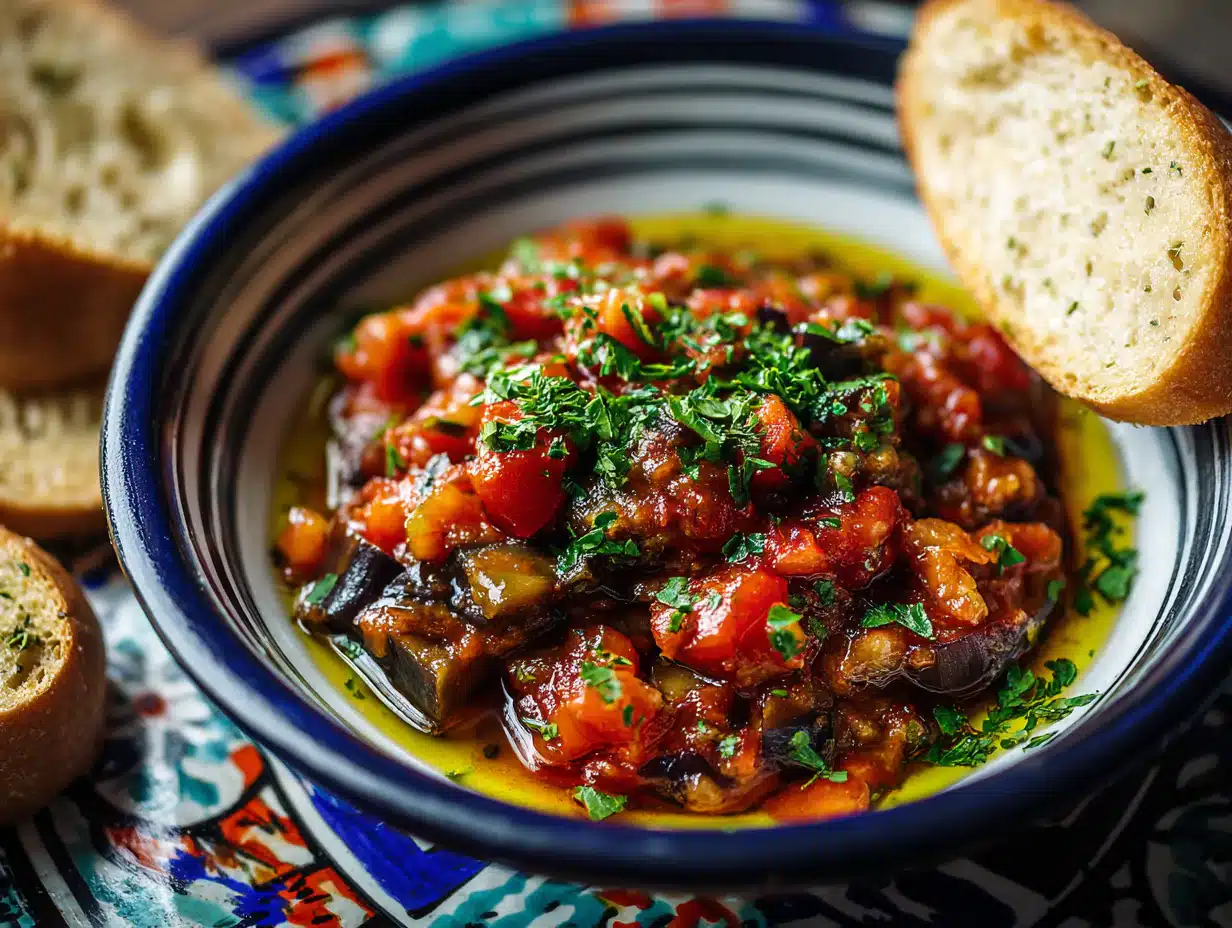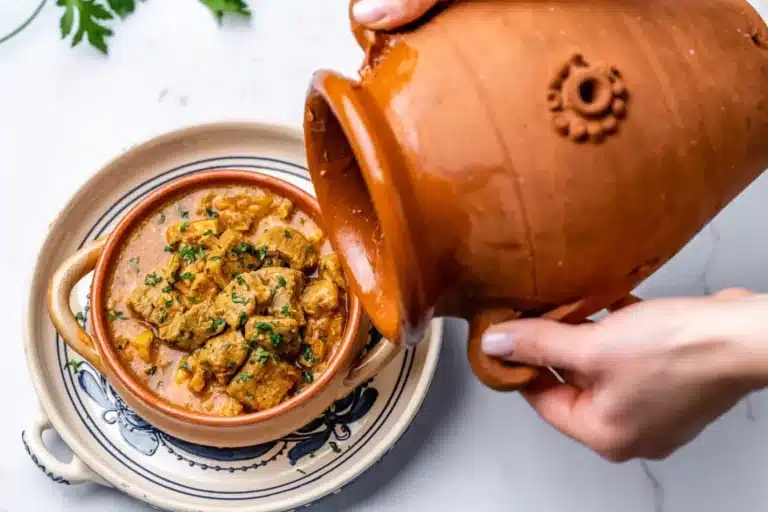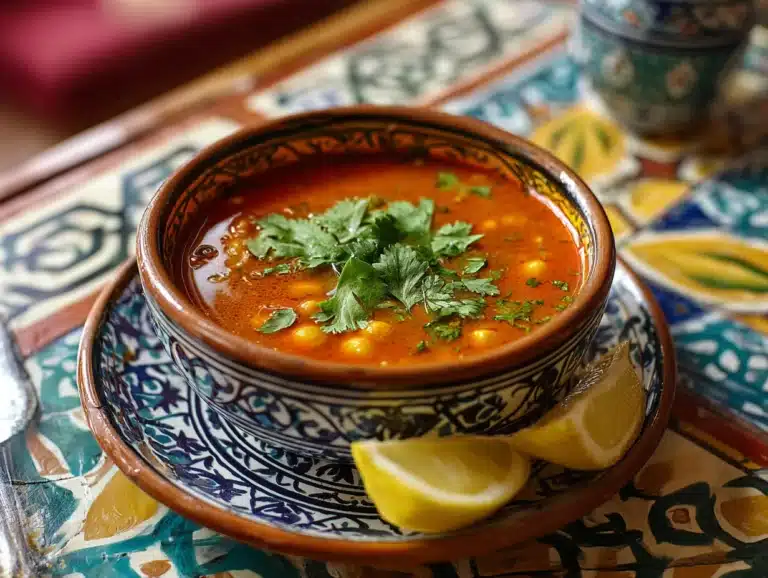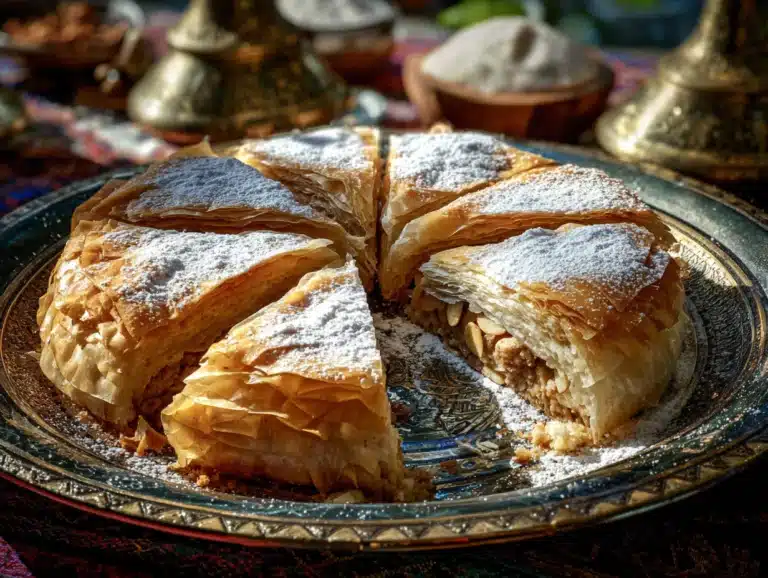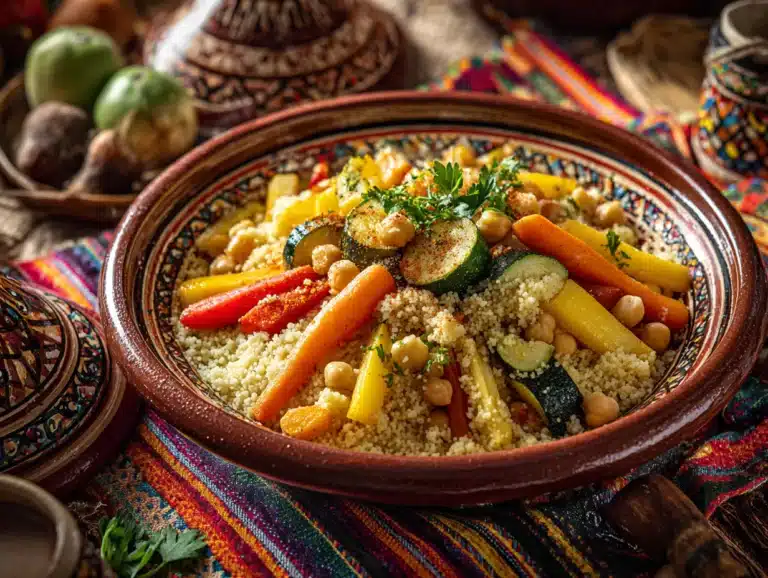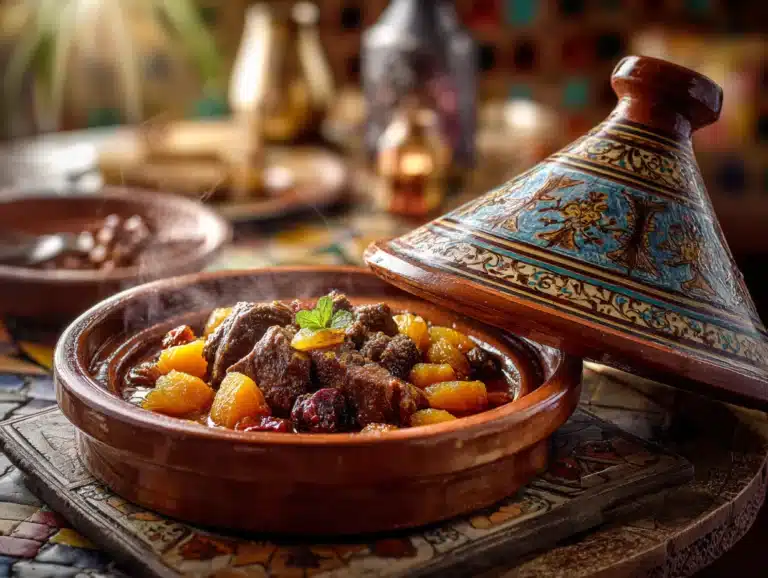Zaalouk: The Best Traditional Moroccan Salad in 5 Easy Steps
Zaalouk is Morocco’s beloved smoky eggplant salad, featuring tender roasted eggplant and tomatoes seasoned with aromatic spices like cumin, paprika, and fresh herbs. This traditional Moroccan dish serves as both a flavorful side dish and a healthy appetizer, perfect for sharing with warm bread or as part of a mezze spread.
Overview of Moroccan Cuisine
Moroccan cuisine represents a rich tapestry of flavors influenced by Berber, Arab, Mediterranean, and French culinary traditions. The cuisine is renowned for its masterful use of spices, creating complex flavor profiles that balance sweet, savory, and aromatic elements.
Traditional Moroccan cooking emphasizes fresh, seasonal ingredients and time-honored techniques passed down through generations. From the iconic tagines to refreshing salads like zaalouk, Moroccan dishes celebrate the country’s diverse agricultural bounty and cultural heritage.
The art of Moroccan cooking lies in the careful layering of spices such as cumin, coriander, cinnamon, and ras el hanout, creating dishes that are both comforting and exotic to international palates.
Best Time to Cook This Dish
Zaalouk recipe is particularly popular during late summer and early autumn when eggplants are at their peak ripeness and flavor. The dish is commonly prepared during Ramadan as part of the iftar meal, providing a refreshing and nutritious option after a day of fasting.
This Moroccan zaalouk recipe is also perfect for warm weather entertaining, as it can be served at room temperature and actually improves in flavor when allowed to rest. Many Moroccan families prepare large batches during family gatherings and celebrations.
The versatility of zaalook makes it suitable year-round, though using fresh, in-season tomatoes and eggplants will yield the most authentic and flavorful results.
Cultural Significance of Zaalouk
In Moroccan culture, zaalouk represents more than just a side dish it embodies the principle of sharing and community that defines Moroccan hospitality. The dish is traditionally served as part of a larger spread of Moroccan salads and appetizers, encouraging communal dining and conversation.
The preparation of zalouk often becomes a family affair, with multiple generations gathering to char eggplants over open flames and share cooking techniques. This ritual preserves culinary traditions while creating opportunities for storytelling and bonding.
The dish also reflects Morocco’s commitment to fresh, healthy eating, incorporating vegetables and herbs that provide both nutrition and medicinal benefits according to traditional Moroccan beliefs.
Ingredients Needed

Main Ingredients:
- 2 large eggplants (approximately 2 pounds)
- 4 medium tomatoes (or 1 can diced tomatoes)
- 1 large onion, finely chopped
- 4 cloves garlic, minced
- 1/4 cup olive oil
Spices and Seasonings:
- 1 teaspoon ground cumin
- 1 teaspoon sweet paprika
- 1/2 teaspoon ground coriander
- 1/4 teaspoon cayenne pepper (optional)
- Salt and black pepper to taste
Fresh Herbs:
- 1/4 cup fresh cilantro, chopped
- 2 tablespoons fresh parsley, chopped
- 1 tablespoon fresh lemon juice
Optional Garnishes:
- Extra virgin olive oil for drizzling
- Preserved lemons, chopped (optional)
- Black olives for serving
Ingredient Substitutions for International Cooks:
- If eggplants are unavailable, zucchini can be substituted, though the texture will differ
- Canned fire-roasted tomatoes work well as a substitute for fresh tomatoes
- Ground spices can be replaced with whole spices toasted and ground fresh for enhanced flavor
Step-by-Step Instructions
Step 1: Prepare the Eggplants
Preheat your oven to 450°F (230°C). Pierce the eggplants all over with a fork to prevent bursting. Place them directly on the oven rack with a baking sheet underneath to catch drips.
Roast for 45-60 minutes, turning once halfway through, until the skin is charred and the flesh is completely soft when pressed.
Step 2: Cool and Peel
Remove eggplants from oven and let cool for 10 minutes. Carefully peel away the charred skin and discard. The flesh should be very soft and smoky.
Roughly chop the eggplant flesh and set aside in a colander to drain excess moisture for 15 minutes.
Step 3: Prepare the Tomato Base
While eggplants drain, heat 2 tablespoons of olive oil in a large skillet over medium heat. Add chopped onions and cook for 5-7 minutes until translucent.
Add minced garlic and cook for another minute until fragrant.
Step 4: Add Tomatoes and Spices
Add chopped tomatoes to the skillet along with cumin, paprika, coriander, and cayenne. Season with salt and pepper.
Cook for 10-15 minutes, stirring occasionally, until tomatoes break down and the mixture becomes thick and concentrated.
Step 5: Combine and Simmer
Add the drained eggplant to the tomato mixture. Use a wooden spoon to gently mash and combine the ingredients, leaving some texture.
Simmer for 15-20 minutes, stirring occasionally, until the mixture is thick and flavors are well combined.
Step 6: Finish and Season
Remove from heat and stir in fresh cilantro, parsley, and lemon juice. Taste and adjust seasoning with salt, pepper, and additional lemon juice as needed.
Drizzle with remaining olive oil and let cool to room temperature before serving.
Cooking Tips & Tricks
Achieving Perfect Texture
The key to authentic Moroccan zaalouk lies in properly charring the eggplants. For the most traditional flavor, char them directly over a gas flame or grill, turning frequently until the skin is completely blackened.
Allow the cooked zaalouk to rest for at least 30 minutes before serving. This resting period allows the flavors to meld and develop complexity.
Spice Customization
Toast whole spices in a dry pan before grinding for maximum flavor impact. This technique elevates the dish beyond what pre-ground spices can achieve.
For a more complex flavor profile, add a pinch of cinnamon or a small amount of ras el hanout during the cooking process.
Consistency Control
If your zaalouk seems too watery, continue cooking over low heat to evaporate excess moisture. The final consistency should be thick enough to hold its shape when spooned.
For a smoother texture, pulse the mixture briefly in a food processor, but avoid over-processing as some texture is desirable.
Serving Suggestions
Zaalouk shines as part of a traditional Moroccan meal alongside other small dishes. Serve it with warm khubz (Moroccan bread) or pita for scooping.
The dish pairs beautifully with grilled meats, particularly lamb or chicken tagines. It also complements other Moroccan salads such as taktouka (pepper and tomato salad) or carrot salad with orange blossom water.
For a modern presentation, serve zaalouk as a healthy dip with vegetables or as a topping for grilled fish or roasted vegetables.
Traditional Accompaniments:
- Fresh mint tea
- Warm flatbread or khubz
- Preserved lemons
- Green olives
- Other Moroccan mezze dishes
Storage & Leftovers
Zaalouk actually improves in flavor when stored in the refrigerator overnight, making it an excellent make-ahead dish. Store covered in the refrigerator for up to 5 days.
The dish can be served cold, at room temperature, or gently rewarmed. If reheating, do so slowly over low heat, adding a splash of water if needed to prevent sticking.
For longer storage, zaalouk can be frozen for up to 3 months. Thaw completely before serving and drain any excess liquid that may have formed.
The flavors continue to develop over time, so day-old zaalouk often tastes even better than freshly made.
Common FAQs
Can I make zaalouk without roasting the eggplants?
While possible, roasting or charring the eggplants is essential for authentic flavor. The smoky char adds depth that cannot be replicated through other cooking methods.
Why is my zaalouk too watery?
Excess moisture usually comes from not draining the eggplant properly or not cooking the tomato mixture long enough. Always drain salted eggplant and cook until thick.
Can I use different vegetables?
Traditional zaalouk uses eggplant, but variations with zucchini or peppers exist. However, these create different dishes with distinct flavors and textures.
How spicy should zaalouk be?
Authentic zaalouk is mildly spiced rather than hot. The heat should be subtle, allowing the smoky eggplant flavor to predominate.
What’s the difference between zaalouk and baba ganoush?
While both feature eggplant, zaalouk includes tomatoes and Moroccan spices, while baba ganoush typically uses tahini and Middle Eastern seasonings.
Conclusion
This traditional zaalouk recipe brings the authentic flavors of Morocco to your kitchen, offering a healthy and delicious addition to any meal. The combination of smoky eggplant, aromatic spices, and fresh herbs creates a dish that’s both satisfying and nutritious.
Whether you’re exploring Moroccan cuisine for the first time or looking to perfect this classic recipe, zaalouk rewards patience and attention to detail with incredible flavor development.
Try this Moroccan recipe today and discover why zaalouk has been a beloved staple in Moroccan households for generations! Subscribe to our newsletter for more authentic Moroccan recipes and cooking tips that will transport your taste buds to the bustling souks of Marrakech.
For more traditional Moroccan recipes, explore our collection of tagine recipes and Moroccan Couscous to create your own authentic Moroccan feast at home.

